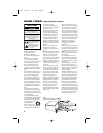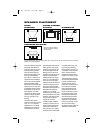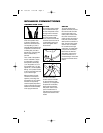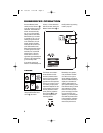7
If there is no sound from any
of the speakers:
• Check that receiver/ampli-
fier is on and a source is
playing.
• Check that the powered
subwoofer is plugged in
and is turned on (Power
switch
å
pushed in).
• Check all wires and con-
nections between receiver/
amplifier and speakers. Make
sure all wires are connected.
Make sure none of
the
speaker wires are frayed,
cut
or punctured, or touching
each other.
• Review proper operation of
your receiver/amplifier.
If there is no sound coming
from one speaker:
• Check the “Balance” control
on your receiver/amplifier.
• Check all wires and con-
nections between receiver/
amplifier and speakers. Make
sure all wires are connected.
Make sure none of the speaker
wires are frayed,
cut or
punctured, or touching each
other.
• In Dolby Digital or DTS
modes, make sure that the
receiver/amplifier is config-
ured so that the speaker in
question is enabled.
• Turn off all electronics
and switch the speaker in
question with one of the
other speakers that is work-
ing correctly. Turn every-
thing back on, and determine
whether the problem has fol-
lowed the speaker or has
remained in the same chan-
nel. If the problem is
in the same channel, the
source of the problem
is most likely with your
receiver or amplifier, and
you should consult the
owner’s manual for that
product for further informa-
tion. If the problem has fol-
lowed the speaker, consult
your dealer for further assis-
tance or, if that is not possi-
ble, visit www.jbl.com.
If there is no sound from the
center speaker:
• Check all wires and con-
nections between receiver/
amplifier and speaker. Make
sure all wires are connected.
Make sure none of the
speaker wires are
frayed,
cut or punctured, or touch-
ing each other.
• If your receiver/processor
is set in Dolby Pro Logic mode,
make sure the center speaker
is not in phantom mode.
• If your receiver/processor
is set in one of the Dolby
Digital or DTS
modes, make
sure the receiver/
processor
is configured so that the
center speaker is enabled.
If the system plays at low
volumes but shuts off as
volume is increased:
• Check all wires and con-
nections between receiver/
processor and speakers.
Make sure all wires are con-
nected. Make sure none of
the speaker wires are
frayed,
cut or punctured, or
touching each other.
• If more than one pair of
main speakers is being used,
check the minimum imped-
ance requirements of your
receiver/amplifier.
If there is low (or no) bass
output:
• Make sure the connections
to the left and right “Speaker
Inputs” have the correct
polarity (+ and –).
• Make sure the subwoofer
is plugged into an active
electrical outlet
and is
turned on (Power switch
å pushed in).
• In Dolby Digital or DTS
modes, make sure your
receiver/processor is config-
ured so that the subwoofer
and LFE output are enabled.
• Switch the Phase switch
ç to the opposite position,
and select the position that
results in the most pleasing
bass response.
If there is no sound from
the surround speakers:
• Check all wires and con-
nections between receiver/
processor and speakers.
Make sure all wires are con-
nected. Make sure none of
the speaker wires are
frayed,
cut or punctured, or
touching each other.
• Review proper operation of
your receiver/amplifier and
its surround sound features.
• Make sure the movie or
TV show you are watching
is recorded in a surround
sound mode. If it is not,
check to see whether your
receiver/processor has other
surround modes you may use.
•
In Dolby Digital or DTS
modes, make sure your
receiver/processor is config-
ured so that the surround
speakers are enabled. When
five satellites are in use,
remember to configure your
receiver or processor for
6.1-channel operation, and
when six satellites are in use,
configure your receiver or
processor for 7.1 channels.
• Review the operation of
your DVD player and the
jacket of your DVD to make
sure that the DVD features
the desired Dolby Digital or
DTS mode, and that you
have properly selected that
mode using both the DVD
player’s menu and the DVD
disc‘s menu.
TROUBLESHOOTING
CS OM 12/2/05 4:43 PM Page 7










